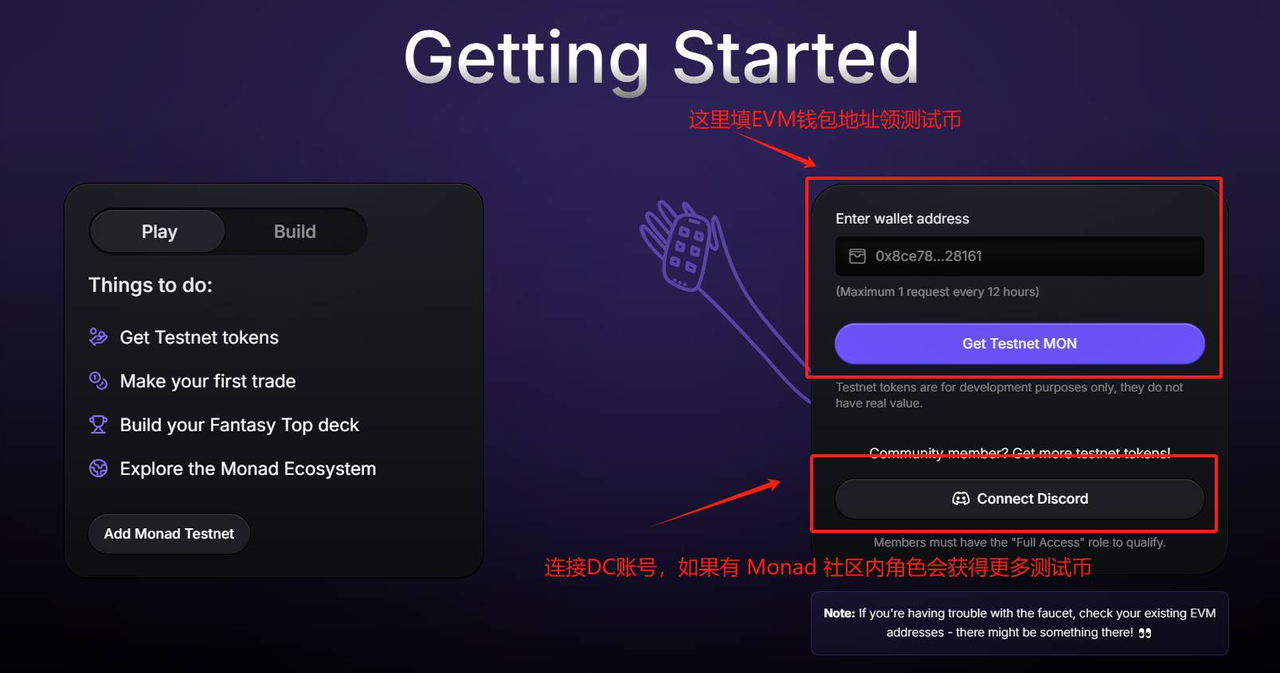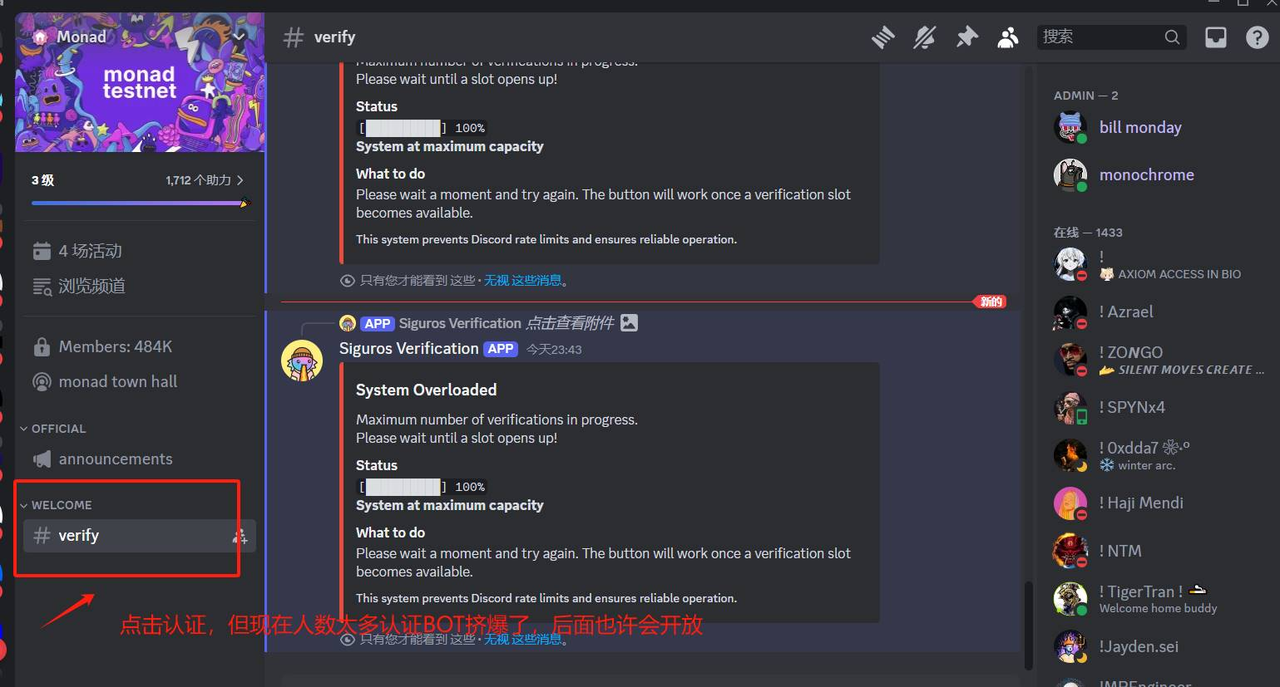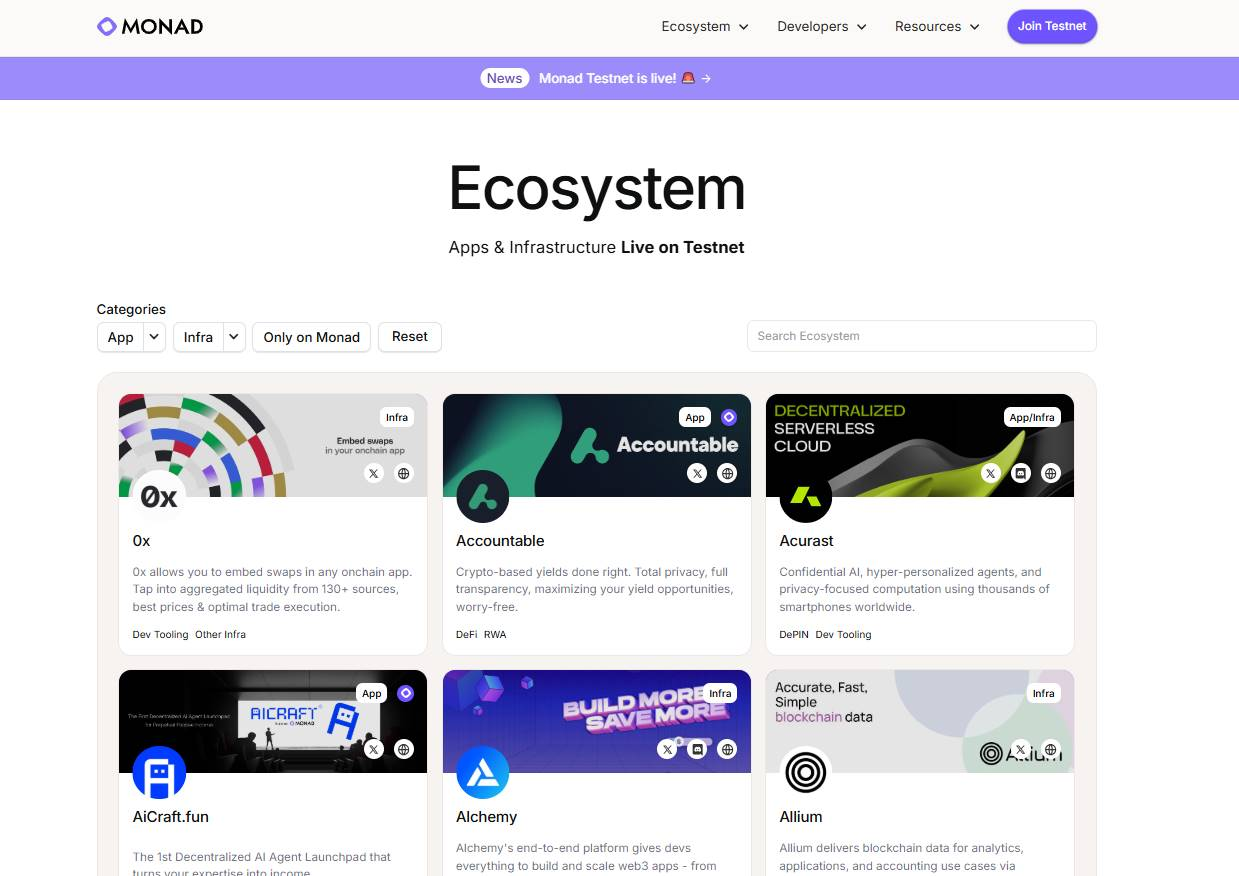No.: PandaLY Hotspot Insights Broadcast No.013
In the wave of blockchain technology iteration, Monad, as a star project that won $225 million in financing in 2024 (valued at over $2 billion), is rewriting the rules of Layer1 competition with "a high-performance blockchain fully compatible with EVM". The project is led by top capitals such as Paradigm and Electric Capital, and launched a public test network covering 8.8 million Ethereum addresses on February 19, 2025, demonstrating strong technical strength. This article will deconstruct its technical breakthrough path, verify the value of the test network data, and market competition, and reveal this rising star project that may subvert the industry landscape - Monad.
1. Technological innovation: technological breakthroughs in four dimensions to build a high-performance moat
Monad is a highly-anticipated Layer 1 blockchain project, positioned as a "high-performance blockchain fully compatible with EVM". It aims to achieve a performance leap through four major technological innovations, solve the scalability bottleneck of the Ethereum network (low TPS, high Gas fees, network congestion), while maintaining EVM compatibility, and create an efficient and user-friendly blockchain network to support large-scale practical applications.
(1) Monad BFT consensus mechanism: BFT consensus mechanism based on HotStuff algorithm to ensure fast transaction verification
Pipeline BFT: Parallelize the three stages of traditional BFT (proposal-vote-submit), reducing the block confirmation time to 0.8 seconds
Dynamic validator set: The initial 100 nodes are dynamically adjusted through reputation scoring, and malicious nodes are kicked out of the network within 24 hours
Anti-sybil design: Introducing hardware fingerprint authentication, a single entity can control up to 3% of the authentication rights
(2) Execution layer revolution: When EVM learns "multithreading"
Dependency graph: Build DAG through transaction input/output analysis and automatically identify parallelizable transaction packages
Conflict resolution mechanism: set up a "dispute buffer" to handle conflicting transactions, which has reduced repeated execution by 30% in actual measurement.
Gas Optimizer: Reconstructing the Gas calculation model for parallel environments, saving 22% of fees for common DeFi contracts
(3) Storage innovation: original MonadDB state database, using SSD-HDD hybrid storage solution
Three-level storage architecture
┌───────────────┐
│ Memory: High-frequency access data (5% state) │
│ SSD: recent block data (70%) │
│ HDD: Historical archive (25%) │
└───────────────┘
Lightweight state proof: zk-STARK is used to generate storage proof, alleviating the risk of SSD data reliability and increasing verification speed by 8 times
(4) EVM compatibility: full EVM bytecode compatibility and Ethereum RPC API compatibility
100% support for Ethereum Shanghai upgraded opcodes and precompiled contracts
Innovative "state sharding precompilation" technology reduces gas consumption of complex contracts by 40%
Provides EVM+ developer kit and supports one-click migration of Solidity/Vyper smart contracts.
2. Testnet launch, data reveals Monad’s explosive potential
The launch of the 2025 test network marks an industry milestone:
8.8 million addresses were airdropped in 30 minutes, with a peak TPS of 5,200
334 million RPC requests were processed within 12 hours, and the API response time was stabilized within 80ms
The developer tool chain integration rate reaches 92%, and mainstream frameworks such as Hardhat/Truffle are seamlessly connected
「How to get test coins」
Basic acquisition channel

The official faucet issues 0.2 MON test coins every 12 hours. It is recommended to complete the Discord identity authentication first to increase the quota.
If the official water collection channel is congested, you can go through the OKX water collection center, https://www.okx.com/zh-han/web3/faucet/monad?id=66, and receive 0.5 MON test coins after completing simple tasks.
Complete community tasks (such as following official social accounts, participating in AMAs, and inviting friends) to receive additional rewards

AMA Participation Reward Mechanism: 100-500 MON test coins will be issued per session
Social fission design: Invite friends to get 20% of the test currency income of the invitee
Use third-party platforms (such as Alchemy, QuickNode) to receive test coins, which is suitable for developers who need large amounts of test coins.
Infrastructure platforms such as Alchemy provide 10,000 MON/day institutional-level test currency quota
Gitcoin bounty program is launched simultaneously, covering 20+ tasks including wallet integration, DEX development, etc.

3. Monad market competition and ecological potential
Dimensions | Bitcoin | Solana | TRON | Monad |
Consensus Mechanism | PoW | PoH+PoS | DPoS | MonadBFT |
Number of nodes | 15,000+ | 1,200 | 27 | 100-200 |
Final time | 60 minutes | 13 seconds | 3 seconds | 1 second |
Transaction costs | 1.5−1.5−50 | $0.00 | $0.01 | $0.001 |
EVM Compatibility | none | part | none | 100% |
The design goal of MONAD is to achieve high throughput and low latency while ensuring security and decentralization through innovative consensus algorithms and security upgrades based on the experience of the above mainstream chains. This will enable it to have excellent transaction performance and provide solid support for various DeFi, GameFi and other applications.
MONAD's high performance and EVM compatibility make it suitable for a variety of application scenarios, such as:
Decentralized Finance (DeFi): Fast transactions and low latency are suitable for efficient trading and liquidity provision.
Non-fungible tokens (NFT): High throughput supports large-scale NFT markets and improves user experience.
Blockchain games: fast transaction confirmation is suitable for real-time interactive games.
Supply Chain Management: Leverage blockchain’s immutability and transparency to efficiently track and authenticate goods.
4. Security Attack and Defense: Risk Warning Behind Innovation
From the perspective of blockchain security companies, Monad’s security features need to be carefully evaluated, and the following risks may exist:
Consensus layer challenges:
Initial validator concentration risk: 60% of the first 100 nodes are institutional nodes.
The staking economic model has not yet been clarified, and there are potential vulnerabilities for Sybil attacks.
Hidden dangers at the execution layer:
Parallel transaction dependency detection needs to be verified through a million-level stress test, and malicious transactions may disrupt the parallel execution order.
EVM compatibility leads to the risk of historical vulnerabilities recurring (the estimated recurrence rate of major Ethereum vulnerabilities in the past three years is 18%)
Storage layer test:
SSD data verification mechanism needs to guard against "false state proof" attacks. SSD storage may forge the state of 3 hours ago.
Data recovery vulnerability: There is a 0.5% probability of state loss when a node restarts
User Protection Guide:
When interacting with Monado, ordinary users should pay attention to the following matters to protect their assets:
Prioritize DApps that have been audited twice
Disable production environment private keys during the testnet phase
Enable the wallet's "transaction dependency detection" plugin
Set a 1 second cooldown period for large transactions
Disable automatic signing of unverified contracts
V. Conclusion
Monad's technical map reveals a profound industry trend: the evolution of blockchain is shifting from "single feature breakthrough" to "system-level architecture innovation". Through the triple innovation of HotStuff consensus transformation, parallel execution engine, and layered storage design, the project has achieved an order of magnitude performance leap while maintaining the ecological inheritance of EVM. The airdrop scale and stability data of the test network confirm the feasibility of its technical route.
But the real disruption has not yet arrived. When the mainnet goes online and faces real economic incentives, its BFT mechanism's anti-attack capabilities, the boundary effects of parallel execution, and the reliability of storage verification will be severely tested. More importantly, how to maintain the essence of decentralization in performance leaps, build differentiated advantages in ecological migration, and maintain protocol neutrality in the face of capital coercion - the answers to these questions will determine whether Monad will become a true Layer1 disruptor or just another footnote to technological idealism.
The next 18 months will be a critical observation period: the first stress test data after the mainnet is launched, the migration ratio of the top 20 Ethereum protocols, the health of the distribution of validator nodes and other indicators will constitute the core coordinate system for evaluating its success or failure. In the foreseeable Layer1 war, Monad has occupied the technical commanding heights, but the ultimate competition in the blockchain world is always a contest of ecological value capture capabilities.












